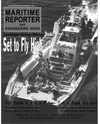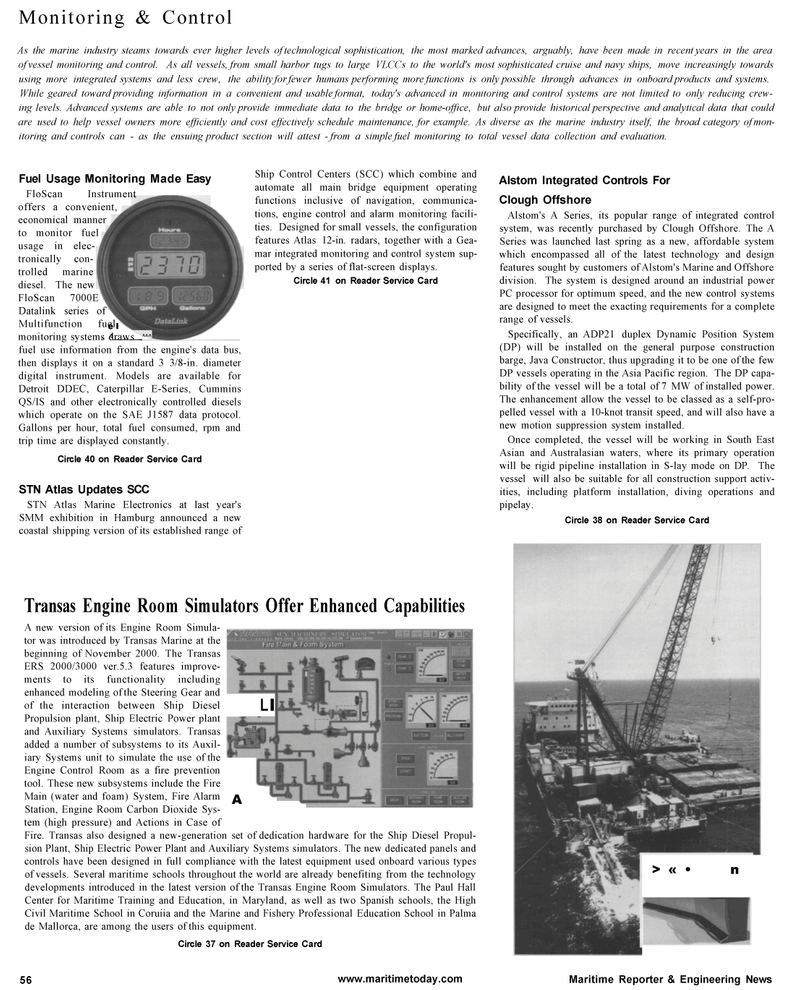
Page 56: of Maritime Reporter Magazine (January 2001)
Read this page in Pdf, Flash or Html5 edition of January 2001 Maritime Reporter Magazine
Monitoring & Control
As the marine industry steams towards ever higher levels of technological sophistication, the most marked advances, arguably, have been made in recent years in the area of vessel monitoring and control. As all vessels, from small harbor tugs to large VLCCs to the world's most sophisticated cruise and navy ships, move increasingly towards using more integrated systems and less crew, the ability for fewer humans performing more functions is only possible through advances in onboard products and systems.
While geared toward providing information in a convenient and usable format, today's advanced in monitoring and control systems are not limited to only reducing crew- ing levels. Advanced systems are able to not only provide immediate data to the bridge or home-office, but also provide historical perspective and analytical data that could are used to help vessel owners more efficiently and cost effectively schedule maintenance, for example. As diverse as the marine industry itself, the broad category of mon- itoring and controls can - as the ensuing product section will attest - from a simple fuel monitoring to total vessel data collection and evaluation.
Ship Control Centers (SCC) which combine and automate all main bridge equipment operating functions inclusive of navigation, communica- tions, engine control and alarm monitoring facili- ties. Designed for small vessels, the configuration features Atlas 12-in. radars, together with a Gea- mar integrated monitoring and control system sup- ported by a series of flat-screen displays.
Circle 41 on Reader Service Card
Alstom Integrated Controls For
Clough Offshore
Alstom's A Series, its popular range of integrated control system, was recently purchased by Clough Offshore. The A
Series was launched last spring as a new, affordable system which encompassed all of the latest technology and design features sought by customers of Alstom's Marine and Offshore division. The system is designed around an industrial power
PC processor for optimum speed, and the new control systems are designed to meet the exacting requirements for a complete range of vessels.
Specifically, an ADP21 duplex Dynamic Position System (DP) will be installed on the general purpose construction barge, Java Constructor, thus upgrading it to be one of the few
DP vessels operating in the Asia Pacific region. The DP capa- bility of the vessel will be a total of 7 MW of installed power.
The enhancement allow the vessel to be classed as a self-pro- pelled vessel with a 10-knot transit speed, and will also have a new motion suppression system installed.
Once completed, the vessel will be working in South East
Asian and Australasian waters, where its primary operation will be rigid pipeline installation in S-lay mode on DP. The vessel will also be suitable for all construction support activ- ities, including platform installation, diving operations and pipelay.
Circle 38 on Reader Service Card
Fuel Usage Monitoring Made Easy
FloScan Instrument offers a convenient, economical manner to monitor fuel usage in elec- tronically con- trolled marine diesel. The new
FloScan 7000E
Datalink series of
Multifunction fuel monitoring systems draws fuel use information from the engine's data bus, then displays it on a standard 3 3/8-in. diameter digital instrument. Models are available for
Detroit DDEC, Caterpillar E-Series, Cummins
QS/IS and other electronically controlled diesels which operate on the SAE J1587 data protocol.
Gallons per hour, total fuel consumed, rpm and trip time are displayed constantly.
Circle 40 on Reader Service Card e I „ A ^^^
STN Atlas Updates SCC
STN Atlas Marine Electronics at last year's
SMM exhibition in Hamburg announced a new coastal shipping version of its established range of
Transas Engine Room Simulators Offer Enhanced Capabilities
A new version of its Engine Room Simula- tor was introduced by Transas Marine at the beginning of November 2000. The Transas
ERS 2000/3000 ver.5.3 features improve- ments to its functionality including enhanced modeling of the Steering Gear and of the interaction between Ship Diesel
Propulsion plant, Ship Electric Power plant and Auxiliary Systems simulators. Transas added a number of subsystems to its Auxil- iary Systems unit to simulate the use of the
Engine Control Room as a fire prevention tool. These new subsystems include the Fire
Main (water and foam) System, Fire Alarm
Station, Engine Room Carbon Dioxide Sys- tem (high pressure) and Actions in Case of
Fire. Transas also designed a new-generation set of dedication hardware for the Ship Diesel Propul- sion Plant, Ship Electric Power Plant and Auxiliary Systems simulators. The new dedicated panels and controls have been designed in full compliance with the latest equipment used onboard various types of vessels. Several maritime schools throughout the world are already benefiting from the technology developments introduced in the latest version of the Transas Engine Room Simulators. The Paul Hall
Center for Maritime Training and Education, in Maryland, as well as two Spanish schools, the High
Civil Maritime School in Coruiia and the Marine and Fishery Professional Education School in Palma de Mallorca, are among the users of this equipment.
Circle 37 on Reader Service Card
Ll
A >«• n 56 www.maritimetoday.com Maritime Reporter & Engineering News

 55
55

 57
57
